Abstract
1. Human skin mast cells, unlike other human mast cells so far studied, released histamine in a concentration-related manner in response to substance P, vasoactive intestinal peptide (VIP) and somatostatin (1 microM to 30 microM). In contrast, eledoisin, physalaemin, neurokinin A, neurokinin B, calcitonin gene-related peptide (CGRP), neurotensin, bradykinin and Lys-bradykinin induced negligible histamine release. 2. The low histamine releasing activity of physalaemin, eledoisin, neurokinin A and neurokinin B relative to substance P suggests that the human skin mast cell activation site is distinct from the tachykinin NK-1, NK-2 or NK-3 receptors described in smooth muscle. 3. The relative potencies of substance P and its fragments SP2-11, SP3-11, SP4-11 and SP1-4 in releasing histamine from human skin mast cells suggests that both the basic N-terminal amino acids and the lipophilic C-terminal portion of substance P are essential for activity. 4. Peptide-induced histamine release, like that induced by compound 48/80, morphine and poly-L-lysine, is rapid, reaching completion in 10-20 s, is largely independent of extracellular calcium but requires intact glycolysis and oxidative phosphorylation. 5. The substance P analogue, [D-Pro4,D-Trp7,9,10] SP4-11 (SPA), not only reduced substance P-induced histamine release in a concentration-related manner but also inhibited that induced by VIP, somatostatin, compound 48/80, poly-L-lysine and morphine but not anti-IgE. 6. The similar characteristics of histamine release induced by substance P, VIP, somatostatin, compound 48/80, poly-L-lysine and morphine suggest that they share a common pathway of activation-secretion coupling distinct from that of IgE-dependent activation. Furthermore, the ability of human skin mast cells to respond to basic non-immunological stimuli including neuropeptides may reflect a specialised function for these cells.
Full text
PDF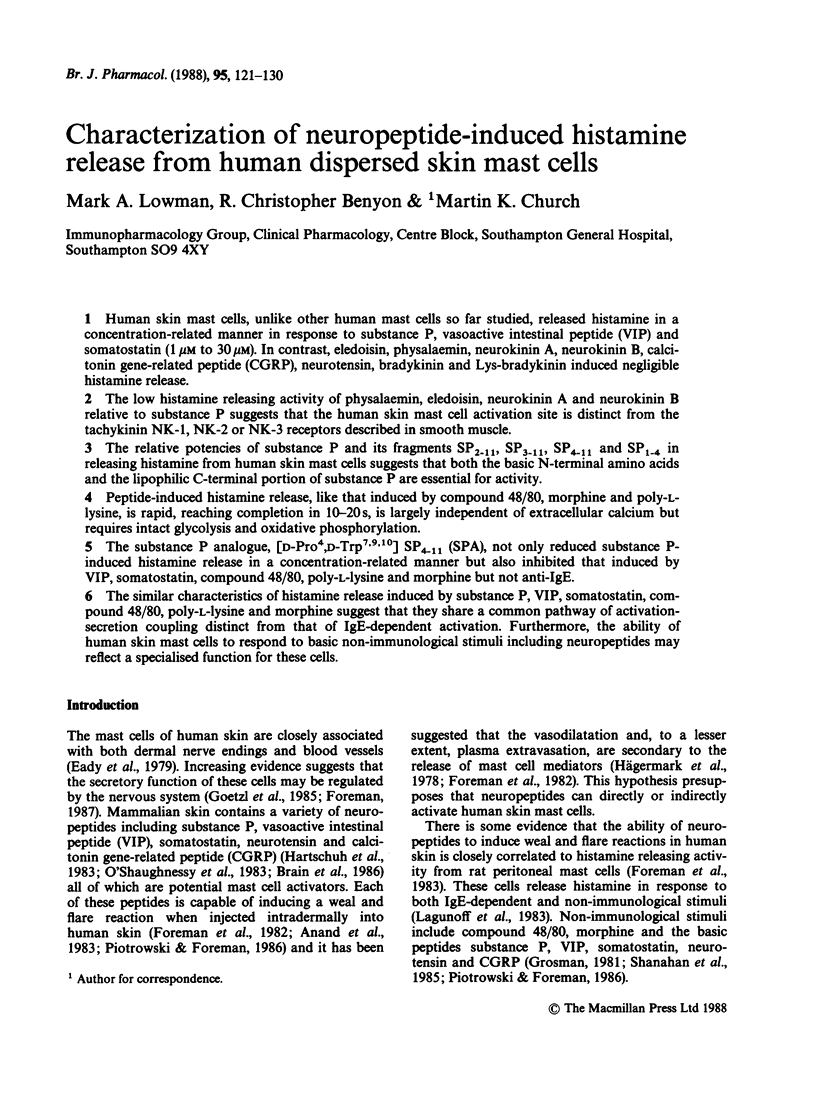

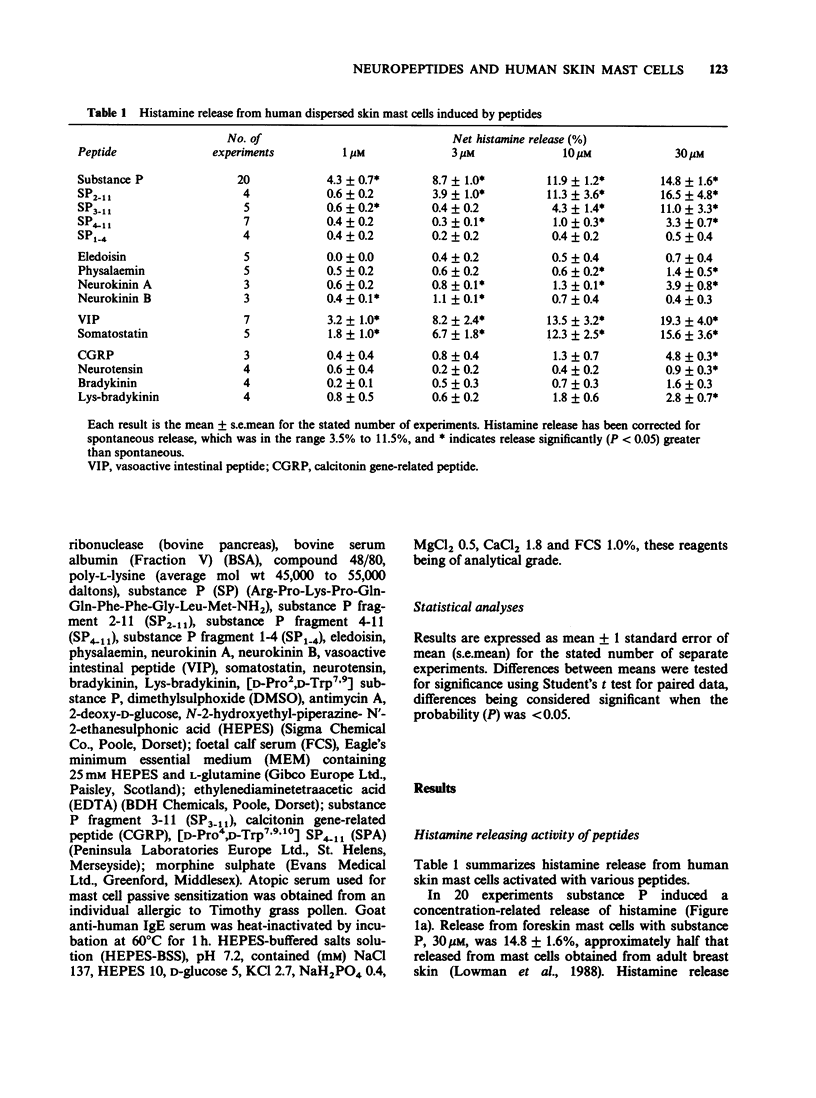


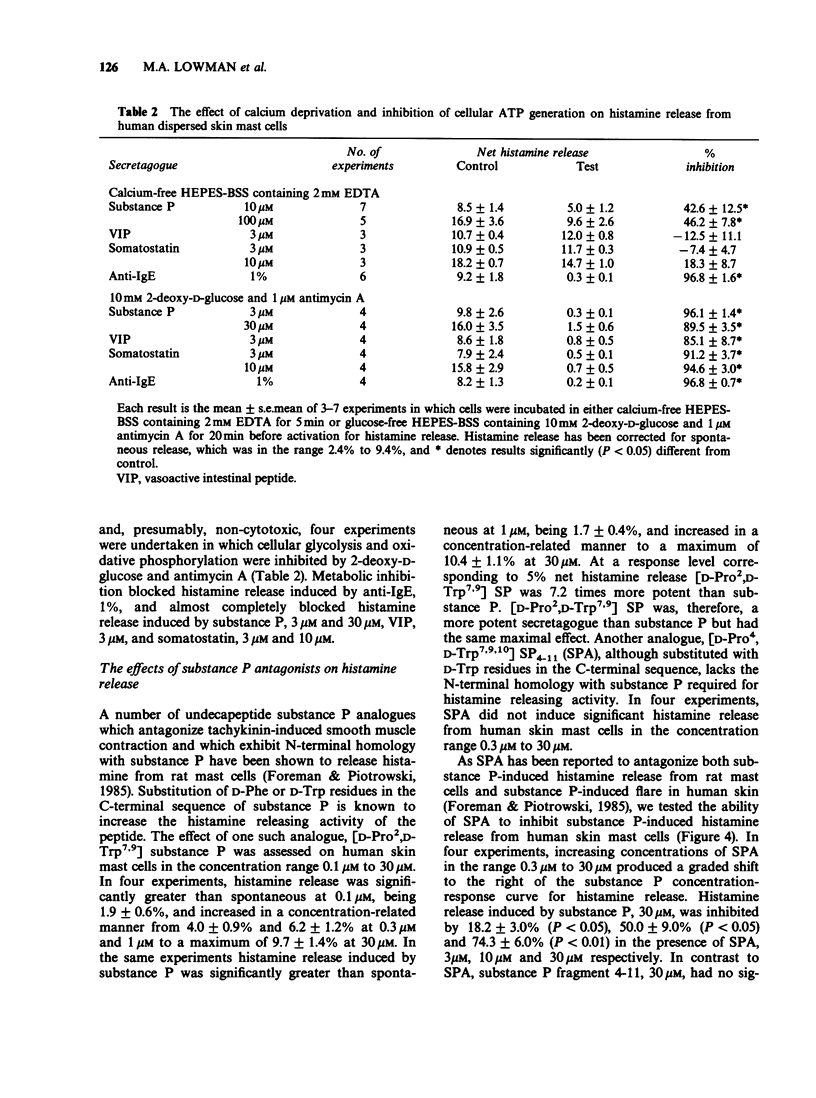
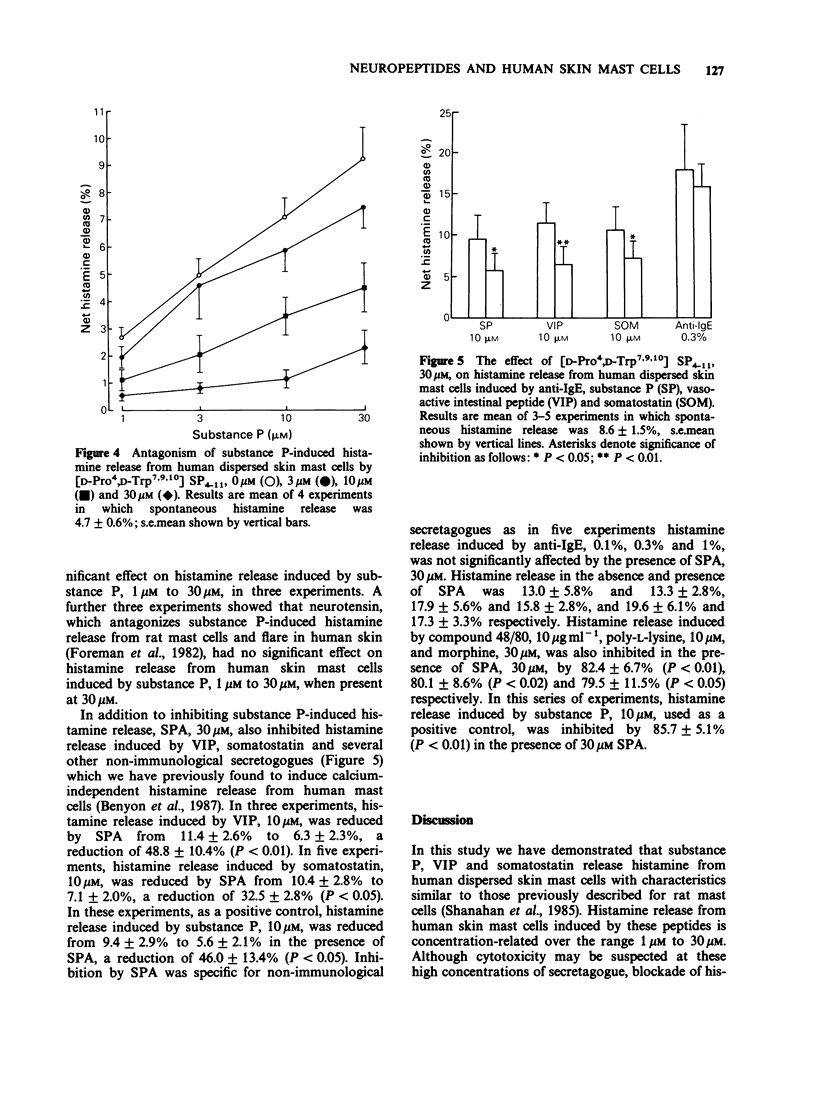

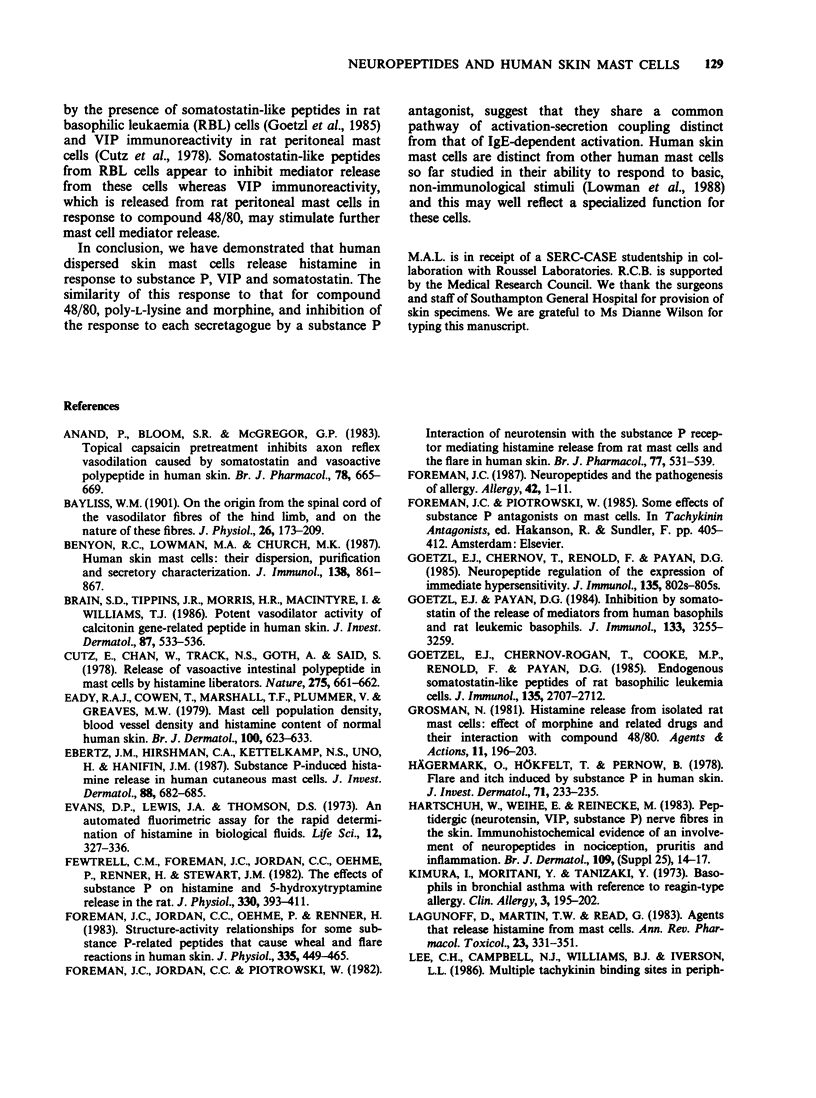
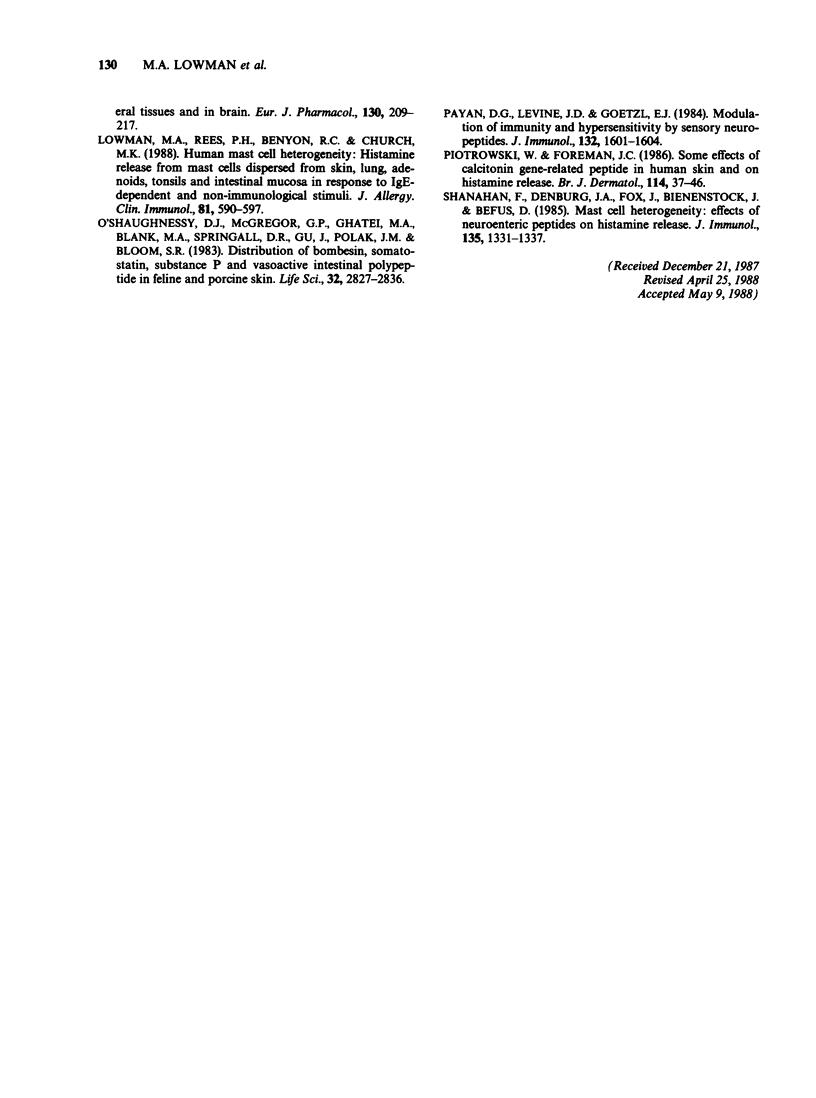
Selected References
These references are in PubMed. This may not be the complete list of references from this article.
- Anand P., Bloom S. R., McGregor G. P. Topical capsaicin pretreatment inhibits axon reflex vasodilatation caused by somatostatin and vasoactive intestinal polypeptide in human skin. Br J Pharmacol. 1983 Apr;78(4):665–669. doi: 10.1111/j.1476-5381.1983.tb09418.x. [DOI] [PMC free article] [PubMed] [Google Scholar]
- Bayliss W. M. On the origin from the spinal cord of the vaso-dilator fibres of the hind-limb, and on the nature of these fibres. J Physiol. 1901 Feb 28;26(3-4):173–209. doi: 10.1113/jphysiol.1901.sp000831. [DOI] [PMC free article] [PubMed] [Google Scholar]
- Benyon R. C., Lowman M. A., Church M. K. Human skin mast cells: their dispersion, purification, and secretory characterization. J Immunol. 1987 Feb 1;138(3):861–867. [PubMed] [Google Scholar]
- Brain S. D., Tippins J. R., Morris H. R., MacIntyre I., Williams T. J. Potent vasodilator activity of calcitonin gene-related peptide in human skin. J Invest Dermatol. 1986 Oct;87(4):533–536. doi: 10.1111/1523-1747.ep12455620. [DOI] [PubMed] [Google Scholar]
- Cutz E., Chan W., Track N. S., Goth A., Said S. I. Release of vasoactive intestinal polypeptide in mast cells by histamine liberators. Nature. 1978 Oct 19;275(5681):661–662. doi: 10.1038/275661a0. [DOI] [PubMed] [Google Scholar]
- Eady R. A., Cowen T., Marshall T. F., Plummer V., Greaves M. W. Mast cell population density, blood vessel density and histamine content in normal human skin. Br J Dermatol. 1979 Jun;100(6):623–633. doi: 10.1111/j.1365-2133.1979.tb08065.x. [DOI] [PubMed] [Google Scholar]
- Ebertz J. M., Hirshman C. A., Kettelkamp N. S., Uno H., Hanifin J. M. Substance P-induced histamine release in human cutaneous mast cells. J Invest Dermatol. 1987 Jun;88(6):682–685. doi: 10.1111/1523-1747.ep12470339. [DOI] [PubMed] [Google Scholar]
- Evans D. P., Lewis J. A., Thomson D. S. An automated fluorimetric assay for the rapid determination of histamine in biological fluids. Life Sci II. 1973 Apr 8;12(7):327–336. doi: 10.1016/0024-3205(73)90366-4. [DOI] [PubMed] [Google Scholar]
- Fewtrell C. M., Foreman J. C., Jordan C. C., Oehme P., Renner H., Stewart J. M. The effects of substance P on histamine and 5-hydroxytryptamine release in the rat. J Physiol. 1982 Sep;330:393–411. doi: 10.1113/jphysiol.1982.sp014347. [DOI] [PMC free article] [PubMed] [Google Scholar]
- Foreman J. C., Jordan C. C., Oehme P., Renner H. Structure-activity relationships for some substance P-related peptides that cause wheal and flare reactions in human skin. J Physiol. 1983 Feb;335:449–465. doi: 10.1113/jphysiol.1983.sp014543. [DOI] [PMC free article] [PubMed] [Google Scholar]
- Foreman J. C., Jordan C. C., Piotrowski W. Interaction of neurotensin with the substance P receptor mediating histamine release from rat mast cells and the flare in human skin. Br J Pharmacol. 1982 Nov;77(3):531–539. doi: 10.1111/j.1476-5381.1982.tb09328.x. [DOI] [PMC free article] [PubMed] [Google Scholar]
- Foreman J. C. Neuropeptides and the pathogenesis of allergy. Allergy. 1987 Jan;42(1):1–11. doi: 10.1111/j.1398-9995.1987.tb02180.x. [DOI] [PubMed] [Google Scholar]
- Goetzl E. J., Chernov-Rogan T., Cooke M. P., Renold F., Payan D. G. Endogenous somatostatin-like peptides of rat basophilic leukemia cells. J Immunol. 1985 Oct;135(4):2707–2712. [PubMed] [Google Scholar]
- Goetzl E. J., Chernov T., Renold F., Payan D. G. Neuropeptide regulation of the expression of immediate hypersensitivity. J Immunol. 1985 Aug;135(2 Suppl):802s–805s. [PubMed] [Google Scholar]
- Goetzl E. J., Payan D. G. Inhibition by somatostatin of the release of mediators from human basophils and rat leukemic basophils. J Immunol. 1984 Dec;133(6):3255–3259. [PubMed] [Google Scholar]
- Grosman N. Histamine release from isolated rat mast cells: effect of morphine and related drugs and their interaction with compound 48/80. Agents Actions. 1981 May;11(3):196–203. doi: 10.1007/BF01967614. [DOI] [PubMed] [Google Scholar]
- Hartschuh W., Weihe E., Reinecke M. Peptidergic (neurotensin, VIP, substance P) nerve fibres in the skin. Immunohistochemical evidence of an involvement of neuropeptides in nociception, pruritus and inflammation. Br J Dermatol. 1983 Jul;109 (Suppl 25):14–17. doi: 10.1111/j.1365-2133.1983.tb06811.x. [DOI] [PubMed] [Google Scholar]
- Hägermark O., Hökfelt T., Pernow B. Flare and itch induced by substance P in human skin. J Invest Dermatol. 1978 Oct;71(4):233–235. doi: 10.1111/1523-1747.ep12515092. [DOI] [PubMed] [Google Scholar]
- Kimura I., Moritani Y., Tanizaki Y. Basophils in bronchial asthma with reference to reagin-type allergy. Clin Allergy. 1973 Jun;3(2):195–202. doi: 10.1111/j.1365-2222.1973.tb01321.x. [DOI] [PubMed] [Google Scholar]
- Lagunoff D., Martin T. W., Read G. Agents that release histamine from mast cells. Annu Rev Pharmacol Toxicol. 1983;23:331–351. doi: 10.1146/annurev.pa.23.040183.001555. [DOI] [PubMed] [Google Scholar]
- Lowman M. A., Rees P. H., Benyon R. C., Church M. K. Human mast cell heterogeneity: histamine release from mast cells dispersed from skin, lung, adenoids, tonsils, and colon in response to IgE-dependent and nonimmunologic stimuli. J Allergy Clin Immunol. 1988 Mar;81(3):590–597. [PubMed] [Google Scholar]
- O'Shaughnessy D. J., McGregor G. P., Ghatei M. A., Blank M. A., Springall D. R., Gu J., Polak J. M., Bloom S. R. Distribution of bombesin, somatostatin, substance-P and vasoactive intestinal polypeptide in feline and porcine skin. Life Sci. 1983 Jun 20;32(25):2827–2836. doi: 10.1016/0024-3205(83)90318-1. [DOI] [PubMed] [Google Scholar]
- Payan D. G., Levine J. D., Goetzl E. J. Modulation of immunity and hypersensitivity by sensory neuropeptides. J Immunol. 1984 Apr;132(4):1601–1604. [PubMed] [Google Scholar]
- Piotrowski W., Foreman J. C. Some effects of calcitonin gene-related peptide in human skin and on histamine release. Br J Dermatol. 1986 Jan;114(1):37–46. doi: 10.1111/j.1365-2133.1986.tb02777.x. [DOI] [PubMed] [Google Scholar]
- Shanahan F., Denburg J. A., Fox J., Bienenstock J., Befus D. Mast cell heterogeneity: effects of neuroenteric peptides on histamine release. J Immunol. 1985 Aug;135(2):1331–1337. [PubMed] [Google Scholar]


